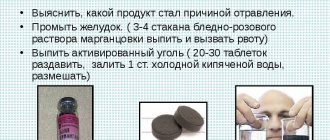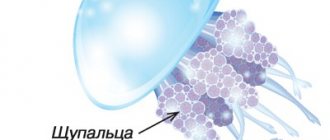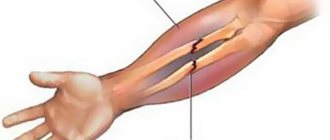What is a bruise
Injury to soft tissues with preservation of the integrity of the skin, resulting from a mechanical shock. This is how the term “bruise” is deciphered in medicine. The impact can occur accidentally and be caused by some object. The result of its direct impact and kinetic energy is damage to tissue cells. With such an injury, the skin, vascular network and subcutaneous fat take the entire blow, in which a local reaction to the traumatic reagent is triggered.
Classification of bruises
In traumatology, there are several types of bruises:
- heads;
- torso;
- limbs.
If there is a blow to the head or head, the patient's condition is assessed as follows:
- without loss of consciousness;
- with loss of consciousness;
- concussion;
- no concussion.

A blow to the body or object to the body is characterized by:
- with soft tissue rupture;
- tissue trauma with damage to internal organs;
- presence/absence of bleeding.
When hitting limbs or objects on limbs, it is classified as:
- with the presence/absence of fractures;
- joint injury;
- damage to the periosteum;
- with/without ligament rupture.
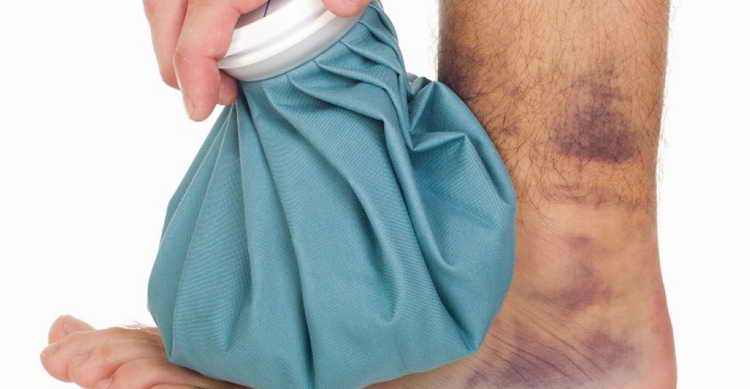
Signs of bruise
The first symptom of a bruise is swelling at the site of the impact and short-term pain. Then, depending on the damaged tissue, they can gradually increase in size. The result is constant intense pain, which causes dysfunction of the muscles in the affected area. The lesion is significantly enlarged relative to the original one. If the vessels are affected, a hematoma appears. This is blood accumulated in the soft tissues, or just a bruise. The extent to which these signs of injury occur depends on the severity of the injury:
- First. This is a slight bruise. Minor skin injuries in the form of abrasions and scratches that do not require special treatment.
- Second. It is characterized by rupture of muscle tissue, the appearance of swelling, hematoma and severe pain.
- Third. In this case, muscles, tissues and tendons are already damaged. This degree of injury is diagnosed more often with dislocations.
- Fourth. Noticeable swelling forms, internal organs suffer, so hospitalization is required for a more accurate diagnosis of the bruise.
How to distinguish a bruise from a fracture
When diagnosing a bruise, it is very important to distinguish it from a fracture. The latter injury is more serious. It is a partial or complete violation of the integrity of cartilage or bone, which is accompanied by damage to the surrounding soft tissue. A bruise should not be confused with an open fracture. In this case, the bone is visible and there is bleeding. A closed fracture may well not be recognized, because it has symptoms similar to a bruise. They can be distinguished by the following characteristics:
- the pain syndrome during a fracture only intensifies over time, and during a bruise, on the contrary, it gradually subsides;
- swelling in case of a bruise appears immediately, and in the case of a fracture only after 2-3 days;
- damage to the integrity of the bone prevents you from leaning on it due to sharp acute pain;
- when the bone is displaced, one can visually observe the deformation of the limbs and even a change in their length compared to healthy ones.
Symptoms of bruises
If the injury is severe, the following symptoms:
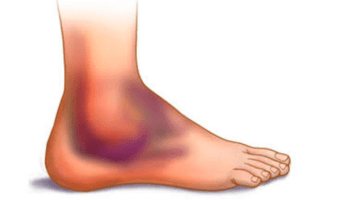
A tumor appears and a hematoma forms.
- pain;
- tumor;
- hematoma;
- limitation of motor function.
The wounded area swells, causing suffering. The painful condition periodically intensifies as a result of the effect on the nerve endings. Then it subsides. The injury lasts for a long time, up to several months, depending on the severity of the injury.
If the integrity of the vessels is damaged, a hematoma appears as a consequence of injury to small vessels. The bruise does not go away for up to two weeks, changing color from purple to yellow.
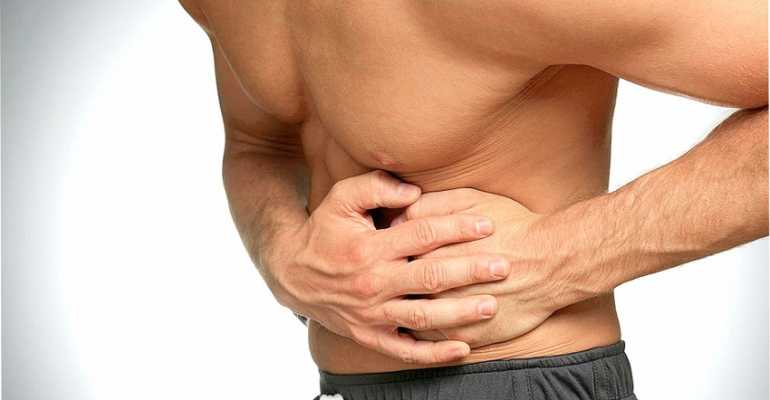
Breathing difficulties occur after a chest injury.
The blow affects the limitation of vital functions of the body: lameness, decreased vision, it is impossible to move the arm. Breathing difficulties occur after a chest injury. The rib area feels like it's burning with pain when trying to breathe in air. It is difficult to breathe deeply, and inside the organs are tightly compressed. I want to squeeze my chest tightly with my hands. Only after this is it possible to breathe.
What to do if you are injured
You can get a bruise anywhere, but a doctor is not nearby in all cases, so it is important to provide yourself or the victim with first aid correctly. Specific measures depend on the injured part of the body, but there are a few general rules that should be followed. These include the following first aid recommendations:
- immediately apply snow, ice, a bubble of cold water or a towel moistened with it, or something else, but always cold, to the site of the bruise;
- For abrasions and scratches, treat the damaged area with iodine or alcohol, then bandage it;
- with bruised joints, dislocation is possible, so the patient must be immobilized;
- the injured limb must be positioned higher relative to the body;
- If the pain is severe, take a painkiller.

First aid for fractures
When providing first aid for fractures, you need to be aware of the symptoms of a fracture. Symptoms of a fracture can be: severe pain, tissue swelling, abnormal joint shape, pain when trying to move the injured limb. However, it is impossible to accurately determine a fracture on your own. Only a doctor in a hospital can determine the symptoms of a fracture and the severity of the injury.
When providing first aid for fractures, first of all it is necessary to fix the injured limb in the position in which it is located. Don't try to put it in place yourself. Before the ambulance arrives, it is necessary to apply a splint using available means (sticks, cardboard, cloth) and ensure complete rest for the victim.
In case of an open fracture, it is necessary to first provide assistance to stop the bleeding, and then provide first aid for fractures.
What is the sequence of first aid
In addition to the general rules of first aid, it is important to know more specific actions, because some of them can be done if one part of the body is bruised and not with another. Each of them reacts to damage in its own way. A bruise on a leg or arm goes away without any complications, but on the head, on the contrary, can lead to serious consequences. For this reason, proper bruise first aid, or bruise first aid, is so important.
For soft tissue bruises
Muscles, skin and subcutaneous tissue are soft tissues. Their injury in most cases is accompanied by a bruise, which can reach large sizes. It can be located anywhere, because soft tissues cover the entire human body. First aid for their injury includes the following measures:
- in case of injury to a limb, she needs to be provided with rest, in other cases simply take a comfortable position;
- to reduce swelling, apply something cold to the damaged area for 10-15 minutes - a bottle of water, ice or even frozen chicken;
- After the specified time, if possible, apply a pressure bandage to the site of the injury;
- if there are wounds or scratches, you should treat them with iodine and apply a sterile bandage to prevent infection;
- if the pain does not subside, you need to take a painkiller, but only if you are absolutely sure that it is a bruise and not a fracture.
If your condition worsens, you should immediately seek help at the hospital. Fainting, weakness, impaired movement functions, shortness of breath, difficulty breathing with severe bruises of the chest, spine or abdominal cavity are a signal of dangerous injuries. This could be muscle rupture, intestinal damage, internal bleeding, which require mandatory medical intervention.
If you hurt your leg
First aid for leg bruises again includes applying something cold to the injury site. It is better to do this through soft fabric. Cold should only be applied for 15 minutes per hour, otherwise there is a high risk of frostbite. In this case, the limb must be freed from shoes, then placed on a hill, for example, a pillow. If bleeding wounds occur on the leg, they should be treated with an antiseptic, and then a clean bandage should be applied. Further first aid measures are as follows:
- a day later, apply dry heat to the damaged area;
- then lubricate with any absorbable ointment;
- To avoid ligament rupture, it is better to go to the emergency room.
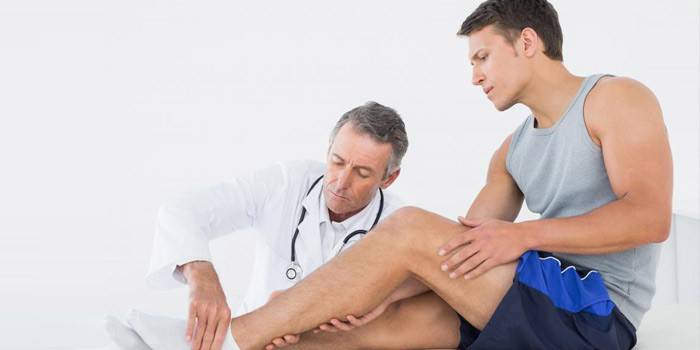
In case of injury to internal organs
Damage to internal organs is often associated with car accidents, falls, and jumps from heights. Bruises affect the chest and abdominal cavity. If the abdomen is injured, a person may feel quite normal, but first aid is simply necessary. It involves the following actions:
- lay the person on his back, bend his legs;
- bandage the bruised area with a tight bandage and apply a cold compress to it;
- do not allow the victim to drink or eat until doctors arrive.
Another dangerous injury to health is a bruise of the chest with damage to the ribs and internal organs, i.e. lungs or heart. It is accompanied by sharp pain and heavy breathing. A chest bruise is dangerous due to possible clinical death. First aid in such a situation includes:
- restriction of physical activity;
- inspect for dents and bulges in the chest that indicate fractures;
- anesthesia;
- cardiac massage and artificial ventilation in case of loss of consciousness and respiratory arrest;
- applying a cold compress and applying a tight bandage.
With a head injury
One of the most dangerous injuries is a head injury. In this case, it is important to determine its extent and the likelihood of serious damage: whether there are signs of a concussion or the threat of hemorrhage. The victim must be placed in a horizontal position, especially if there are symptoms such as nausea, dizziness, and muscle weakness. In case of a brain contusion, no medications should be given, so as not to blur the clinical picture before medical measures are taken. Before the ambulance arrives, you need to provide first aid:
- if there is bleeding, rinse the wound, try to stop the bleeding using bandages, napkins, clean cloth;
- then apply cold to this place;
- when vomiting, turn the victim on his side so that the vomit does not enter the respiratory tract;
- If symptoms increase and a person’s condition worsens, be sure to call an ambulance.

First aid
Providing first aid for bruises that have caused a sharp deterioration in a person’s health - loss of consciousness, severe pain, loss of coordination of movement, and so on, requires immobilizing the patient and transporting him to the emergency room.
- First aid for bruises includes avoiding sprains and fractures. Once you are sure that there are only symptoms of a bruise, you can apply cold to the sore spot. It will be
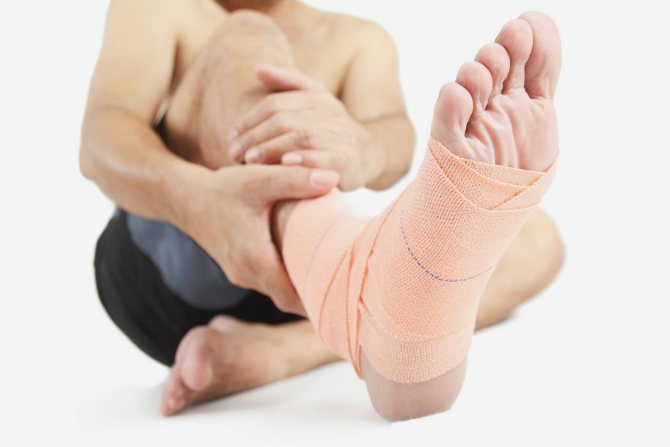
promote vasospasm and stop internal hemorrhage. - If the pain is not too severe, then it is better to be patient and not take painkillers, which can “blur” the further picture and skip additional complications. If you are sure that the internal organs are not damaged, you can give the patient “No-shpu”, “Papaverine”, “Ketanol”. Aspirin is not used to treat bruises, as it increases blood circulation.
- 30 minutes after exposure to cold, the damaged area must be immobilized, and after two days, begin applying a warm compress, which will increase blood flow from the affected area and accelerate the resorption of the hematoma.
Remedies for bruises
After providing first aid, it is important to know how to treat bruises at home. The goal is to reduce swelling, bruising and pain. Depending on the condition, the patient may be prescribed medications for internal or external use. The latter include compresses, which significantly accelerate the healing and resorption of bruises. They are represented by traditional medicine recipes, so it is better to use such methods at home in conjunction with basic therapy.
Compress
This procedure consists of applying certain ingredients to the site of the injury, most of which are present in the kitchen of any housewife. For effectiveness, it is recommended to repeat it three times a day. Any of the compositions is applied to the damaged area, then bandaged or simply pressed with some kind of cloth. The list of the most effective folk recipes includes:
- aloe compress with honey;
- cabbage leaf, pierced in several places;
- chopped boiled beans, which are applied warm to the bruise;
- cold compress of ice;
- plantain crushed to a pulp;
- tea leaves;
- bread crumb soaked in milk.
Medicine
After providing first aid after a bruise, you need to continue to treat them, but with special medications. There are several groups of medications that are used against such injuries:
- hematoma-absorbing ointments and gels based on heparin (Troxevasin, Spasatel, Lyoton);
- vasodilating ointments – Capsicam, ArpizatronYu;
- analgesic and anti-edema enzyme preparations - Wobenzym, Flogenzym;
- non-steroidal anti-inflammatory drugs that relieve swelling and pain - Fastum, Deep Relief, Indovazin.
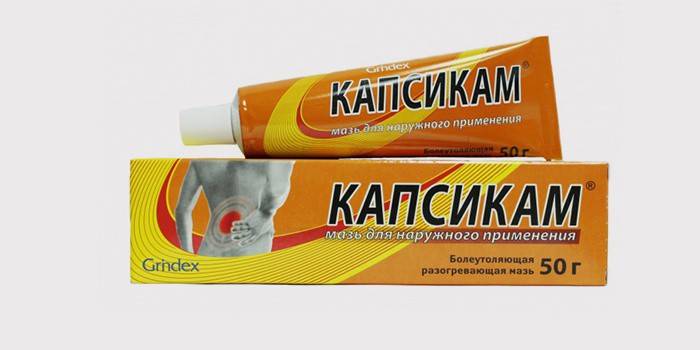
Painkillers
Separately, it is worth noting the group of painkillers. They are presented in capsules or tablets. In terms of safety and effectiveness, Paracetamol, Ibuprofen, Analgin, Ketanov, Diclofenac come first. They can be taken immediately after a bruise to avoid shock and for several days after the injury according to the sensations, if the pain is too severe.
Patch
Of all the methods describing how to treat a bruise, the Nanoplast patch has especially good reviews. It comes in different sizes and works after being glued to the skin. It is often used for a variety of injuries, even by athletes. The patch has anti-inflammatory, analgesic and regenerating effects. The drug is convenient because it is easy to always keep with you, so you can stick the strip on at any time. The patch should not be applied to open wounds or used during pregnancy.
First aid depends on the location of the injury
In addition to the general rules of first aid, you should know more specific actions, since some of the measures that are usually used on one part of the body are contraindicated for use on another. Each of them reacts to trauma in a special way. Damage to the upper or lower extremity often passes without consequences, but a head injury, if assistance is provided incorrectly or untimely, is fraught with serious complications.
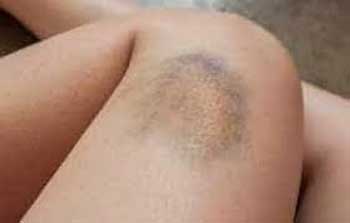
Soft tissue injury: algorithm of actions
The skin, subcutaneous fat, muscles are all soft tissues. Their damage is accompanied by the appearance of a bruise. It can have different sizes and be localized anywhere. This is how you should act in case of soft tissue damage.
- If a limb is bruised, provide it with rest; in other cases, simply take a comfortable position.
- In order to minimize swelling, apply cold to the bruised area for a quarter of an hour, this could be a bottle of water or a frozen piece of meat.
- After 15 minutes, apply a tight bandage to the affected area.
- If there are abrasions, wounds or scratches, treat them with iodine, then apply a sterile bandage to prevent infection.
- If pain persists, take a pain reliever.
If the condition worsens, seek the help of a qualified professional immediately. Pre-fainting, loss of consciousness, malaise, difficulty breathing (if the chest or spine is damaged) - all these symptoms indicate dangerous injuries, in particular muscle rupture, intestinal damage, internal bleeding. Such conditions require qualified help.
What to do if you injured your leg or arm
Emergency treatment for an injury to the lower or upper limb includes the application of cold. It is advisable to do this through soft material, and for no more than a quarter of an hour. If you keep it cold longer, you risk getting frostbite. The actions should be as follows.
- Take off your shoes and place your leg or arm in an elevated position.
- If there is a bleeding wound, treat with an antiseptic and apply a sterile bandage.
- After 24 hours, apply dry heat to the sore spot.
- Lubricate the affected area with absorbable ointment.
- To avoid ligament rupture, go to the emergency room.
Injury to internal organs - abdominal cavity and sternum
The algorithm for providing first aid for internal organ damage depends on the location of the injury. Injuries are often caused by road traffic accidents, falls, or jumps from a height. In this case, it affects the abdominal cavity and chest. Abdominal injury may not manifest itself at all, that is, the patient will feel normal. But he needs urgent help.
- Call a doctor.
- Lay the victim on his back, bend his legs.
- Apply a tight bandage to the damaged area and apply cold.
- Do not give water or food to the patient.
Another health-threatening injury is damage to the sternum (ribs, internal organs, including the heart and lungs). Such a bruise is characterized by sharp and pronounced painful sensations and difficulty breathing. Failure to provide timely assistance to a patient can lead to death. The algorithm of actions is as follows.
- Call an ambulance.
- Limit physical activity and provide the victim with rest.
- Examine the chest for bulges and indentations (signs of a fracture).
- Give the patient a pain reliever.
- If the patient is unconscious, the pulse cannot be felt, and there is no breathing, be prepared to perform resuscitation: artificial respiration and cardiac massage.
- Cover the damaged area with a tight bandage and apply a cold compress.
Head contusion: what to do
This injury is considered one of the most dangerous. The first thing to do is call a doctor and determine the extent and likelihood of serious injury: concussion or hemorrhage. Further actions should be like this.
- Lay the patient down.
- Before the doctor arrives, it is forbidden to give the victim any medications.
- If there is bleeding, wash the wound and try to stop the bleeding (you can use bandages, napkins, a clean cloth).
- Apply cold.
- If vomiting occurs, turn the patient on his side to prevent choking on vomit.
Joint injury (elbow, knee, ankle): what to do
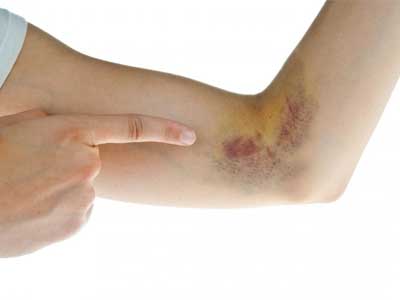
This type of damage is quite common.
- The first thing to do is to limit mobility and give the joint an elevated position. Next, apply ice.
- Then apply a tight bandage.
- Do not bend or straighten the affected joint under any circumstances, massage the damaged area, or apply heat.
- Call a doctor or be prepared to transport the patient to an emergency room.
We have already written about traditional treatment for joint bruises, read the article.
Eye damage
If your eyes are injured, you should immediately call a doctor. While the ambulance is on its way:
- provide yourself or the victim with peace;
- apply cold (a handkerchief moistened with water or cotton wool) for 10 minutes;
- Apply a sterile gauze bandage.
What not to do
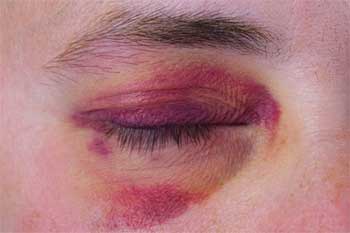
Correctly provided emergency care is the key to further well-being. That is why it is necessary to act quickly and as correctly as possible. When providing assistance for a bruise, never apply cold to the naked body (use a bandage or cloth for this).
Do not allow the victim to move the bruised limb, do not open the hematoma, do not massage or hot compresses for five days (you should also not take hot baths), do not wash your eyes after the bruise, do not transport the patient without a hard stretcher.
Severity
Depending on the severity of the injury, four degrees are distinguished.
- The first, or mild bruise, is characterized by minor damage to the dermis, the appearance of abrasions or scratches. This degree does not require special therapy.
- The second stage is characterized by: rupture of muscle tissue, swelling, severe severe pain and hematoma.
- The third degree is accompanied by damage to muscles, tissues and tendons.
- The fourth is characterized by severe swelling and damage to internal organs. This stage requires immediate emergency care and hospitalization.
How do you know if it's a bruise or a fracture?
At first glance, it is difficult to understand what type of injury was received. Differentiation between these types of injuries is very important, since a fracture is a more serious injury. This disease is characterized by partial or complete disruption of the integrity of cartilage or bone tissue, as well as damage to surrounding soft tissue.
data-ad-format="auto">
An open fracture cannot be confused with anything, but a closed one can easily be considered a dislocation or sprain. The type of damage can be determined by the following manifestations.
| Symptom | In case of injury | At a fracture |
| Painful sensations | gradually subside | are intensifying |
| Swelling | occurs immediately | in 2-3 days |
| Visual deformation of the limb | absent | noticeably |
| Limitation of limb mobility | No | Yes |
Further treatment
Further treatment is prescribed by the doctor after a thorough diagnosis and clarification of the diagnosis. The following drugs are prescribed:
- non-steroidal anti-inflammatory drugs (Deep Rilifa, Fastuma);
- gels and ointments that promote the resorption of hematomas (Rescuer, Lyoton, Troxevasin);
- ointments with vasodilating properties: Capsicam, Apizartron;
- painkillers: Ibuprofen, Paracetamol, Diclofenac;
- enzyme agents: Wobenzyma, Flogenzyma.
Timely provision of emergency assistance, even with what may at first seem like a minor illness such as a bruise, is very important. The health of the patient and his further well-being will depend on the correctness and speed of the response.
data-ad-format="auto">
Treatment of bruises in the elderly
Fragile vessels in older people can cause a huge hematoma even with light blows. For this reason, treatment is best carried out under the supervision of a doctor. To relieve pain, older people are also prescribed non-steroidal anti-inflammatory drugs, for example, Celebrex or Nise. If the symptoms are too pronounced, the application of local anesthetics in the form of Fastum gel or Febrofid ointment is indicated. To avoid complications, it is worth observing bed rest for a couple of days and immobilizing the bruised part of the body.
Treatment of bruises with folk remedies in adults
Most folk first aid recipes for bruises are compresses or lotions. Alcohol tinctures are very effective in this case, because alcohol warms and absorbs all medicinal substances from herbs. For compresses you can use the following recipes:
- Mix 30 g of St. John's wort with 20 g of oak bark and the same amount of marshmallow leaves. Pour in all 300 g of vodka, leave for about 4 days, and strain before use.
- Mix half a liter of vodka with 30 g of linden bark and 3 tablespoons of lemon zest. After 4 days, the product can be used for compresses.
- Pour about 100 g of hop cones into 400 g of vodka, let it stand for 2 days, then use it as a compress on the bruised area.

Contraindications for bruises
There are a number of measures that are not only not included in first aid after bruises, but are completely prohibited, because they can worsen the condition. During the first day, the damaged area should not be heated. This will only increase inflammation. You cannot do the following:
- apply ice directly to the naked body, only through a bandage or cloth;
- actively move the injured limb;
- do massage, hot compresses and baths for 4-5 days;
- open the hematoma at the site of the bruise;
- forcefully bend a joint after an injury;
- wash the eye after a bruise;
- transport the victim without a rigid stretcher in case of a back injury;
- bandage the chest tightly;
- use locally irritating drugs immediately after a bruise.

